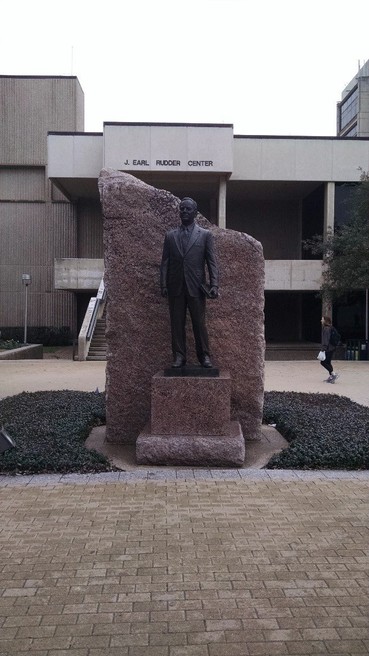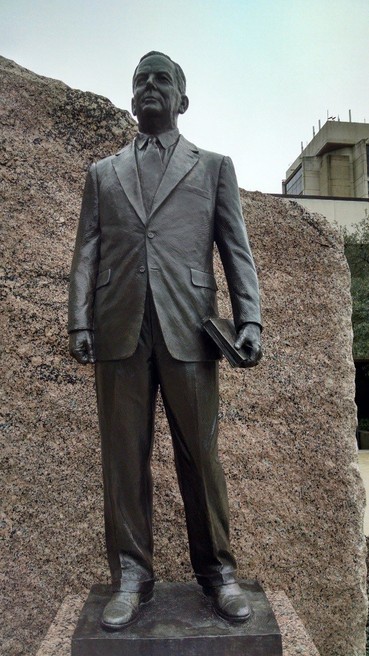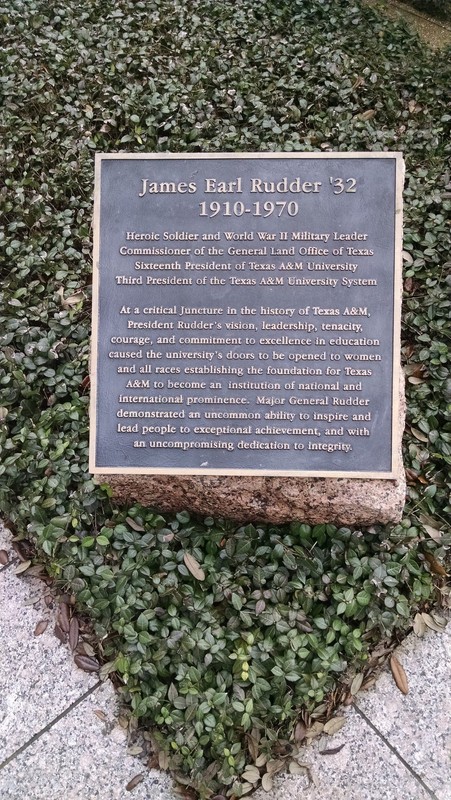James Earl Rudder Statue
Introduction
Text-to-speech Audio
At the heart of the Texas A&M University campus sits a bronze statue of James Earl Rudder. Located in front of the building complex bearing his name, the statue faces towards the historic Military Walk running through campus. Rudder was a famed soldier and Texas public servant, but also has a direct connection to the university having been a student there prior to serving in World War II and then later returning to be president of the university at a pivotal time in its history.
Images
James E. Rudder Statue in front of the Rudder Complex

Close up of James E. Rudder Statue

James E. Rudder Dedication Plaque

Backstory and Context
Text-to-speech Audio
James Earl Rudder remains one of the most iconic figures not only of American history, but also important to both the state of Texas and the history of Texas A&M University. As such, Texas A&M chose to honor the memory of Rudder through placing a large bronze statue of him at the heart of campus. While speaking of his pivotal role at Texas A&M, his biographer Thomas Hatfield stated that “Rudder was a reformer, a pragmatist for whom dwelling on the past was a waste of time. He was a problem-solver, an activist, and a hardnosed do-gooder, intent upon making the world better for others. He was in the Aggie culture but not its prisoner, and he was already a legend, endowed with the talents of the change agent that A&M desperately needed.”1 It is this character that built him into a monumental historical figure and paved the way for the great change that he brought to the university.
James Earl Rudder came from a humble background growing up on the edge of frontier Texas during the 1910s and 1920s without electricity in the home until the age of 15. This was a place where his grandparents advised him to be on the lookout for Indians and Robert E. Lee was held in high esteem. Raised on stories of heroism along with the family’s austere means, Rudder’s childhood experience would shape the character of the man he was to become.
Football changed the course of Rudder’s life leading him away from his hometown of Eden, where he had been a star on the high school football team. His talent earned him an athletic scholarship to John Tarleton Agricultural College, now Tarleton State University. It was here that another life changing event would occur—this is where Rudder first enrolled in an ROTC program.2 Upon completing his basic academic coursework in 1930, Rudder transferred to the Agricultural and Mechanical College of Texas, also known as Texas A.M.C. While there he would continue his passion for sports along with enrollment in the Corps of Cadets. Rudder graduated from Texas A.M.C. with an Industrial Education degree in May 28, 1932, and while he was commissioned a reserve officer in the U.S. Army, he was not immediately called to active duty.
The Great Depression proved to be tough for many Americans to find work, and Rudder was no exception to this. However, Rudder would find his passion in a series of coaching positions that ended up with him coaching football back at his alma mater Tarleton Agricultural College in 1938. Unfortunately, this would be short lived as World War II led the United States to call upon both National Guard and reserve officers to serve.
Rudder received orders to report for duty on June 18, 1941. After many months of training and promotions, Rudder was assigned command of the 2nd Ranger Battalion in 1943. They were soon transferred to England to complete training for a very specific assignment—the Allied invasion of Europe. Rudder’s Rangers achieved fame storming the beaches of Normandy on June 6, 1944 during D-Day. Rudder fought on through France commanding the 109th Infantry Regiment at the Battle of the Bulge. His efforts earned numerous accolades such as the Distinguished Service Cross, Legion of Merit, Silver Star, French Legion of Honor with croix de guerre and palm. Following the war, he eventually gained promotion to Major General while serving in the Army Reserve.
Upon returning to Texas, James Earl Rudder decided that it was time to enter politics. He was elected mayor of Brady from 1946 to 1952. In 1955, Rudder was appointed to serve out the remainder of a term for Commissioner of the Texas Land Office for the State of Texas. While commissioner, Rudder led the charge on a wave of reform that would earn him re-election to the position in 1956, and he also gained enough recognition of his efforts to be offered a new opportunity for reform and impacting people’s lives.
In 1958, James Earl Rudder accepted the leadership position at his alma mater, Texas A&M College, which at that point meant he held the title of Vice President and then changed to President in 1959. While there, Rudder took the school from a “parochial, military school” to a “premier educational institution” with a host of reforms.3 Taking the helm during the beginning of the turbulent 1960s, he proved to be the right person to guide the school through this period. He advocated for radical changes to the all-male military school: making the school co-educational; ending compulsory military training; changing the name of the school to Texas A&M University to reflect its academic evolution; and even racially integrating the school. At a time of radical change and tempestuous moments at college campuses across the nation, Rudder helped transform Texas A&M into the leading institution that it was to become. Unfortunately, James Earl Rudder would not live to see all of his changes come to fruition as he died suddenly in March 1970 at the age of 59.
The statue of James Earl Rudder that stands today honors the great American, Texan, and Aggie hero. Illustrative of his role in shaping the university, the statue is appropriately situated in the middle of campus at the head of the famed Military Walk. The “larger-than-life” statue was unveiled in 1994.4 It was sculpted by Lawrence Ludtke (Texas A&M Class of 1951) with the approval of Rudder’s widow, Margaret Rudder. The original clay mold of the statue was made from the same clay used by famed Italian sculptor Pompeo Coppini who created the Lawrence Sullivan Ross statue on the Texas A&M campus. The Ludtke statue depicts Rudder in civilian clothes, emblematic of his time as Texas A&M’s third President. Standing tall behind the statue is a large slab of ragged marble quarried from Marble Falls, Texas, just a few miles from Brady where Rudder had been mayor. The marble represents the cliffs at Pointe du Hoc that Rudder and his rangers had to scale on the beaches of Normandy during the D-Day invasion. The statue is meant to be impressive, reflecting the importance of the subject and highlighting his pivotal role in history.
Sources
1. Thomas M. Hatfield, Rudder: From Leader to Legend (College Station, TX: Texas A&M University Press, 2011), 304.
2. ROTC stands for Reserve Officers Training Corps. When enrolled, students are expected to take courses on military training.
3. Christopher B. Bean, “James Earl Rudder and the Transformation of Texas A&M University,” Journal of South Texas 21, no. 2 (Fall 2008): 120.
4. Mike L. Downey, “A Legacy in Clay,” Texas Aggie 85, no. 1 (January-February 2004): 42, 45.
Bibliography
2. ROTC stands for Reserve Officers Training Corps. When enrolled, students are expected to take courses on military training.
3. Christopher B. Bean, “James Earl Rudder and the Transformation of Texas A&M University,” Journal of South Texas 21, no. 2 (Fall 2008): 120.
4. Mike L. Downey, “A Legacy in Clay,” Texas Aggie 85, no. 1 (January-February 2004): 42, 45.
Bibliography
Adams, John A. “Texas Aggies Honored in Bastogne – James Earl Rudder.” Texas A&M Today, September 30, 2014. Accessed February 20, 2018. https://today.tamu.edu/2014/09/30/texas-aggies-honored-in-bastogne-james-earl-rudder/.
Bean, Christopher B. “James Earl Rudder and the Transformation of Texas A&M University.” Journal of South Texas 21, no. 2 (Fall 2008): 119-140.
Dethloff, Henry C. and John A. Adams, Jr. Texas Aggies Go to War: In Service of their Country. College Station, TX: Texas A&M University Press, 2006.
Downey, Mike L. “A Legacy in Clay.” Texas Aggie 85, no. 1 (January-February 2004): 42-47.
Handbook of Texas Online, William N. Todd IV and Gerald Knape, "Rudder, James Earl," accessed February 20, 2018, http://www.tshaonline.org/handbook/online/articles/fru06.
Hatfield, Thomas M. Rudder: From Leader to Legend. College Station, TX: Texas A&M University Press, 2011.
Garcia, Rolando. “Rudder's big battles big battles.” The Battalion, October 3, 2001. Accessed February 20, 2018. http://www.thebatt.com/news/rudder-s-big-battles-big-battles/article_573a70c1-7549-545f-b855-ac2d40f....
Lane, Ronald L. Rudder’s Rangers. Manassas, VA: Ranger Associates, 1979.
